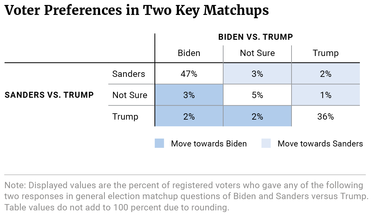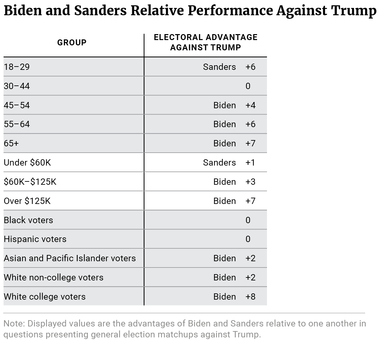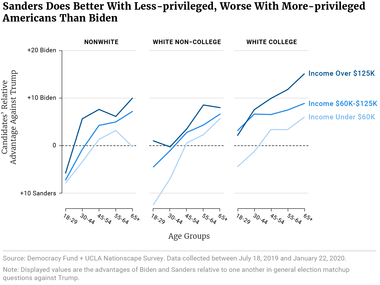Elections, Political Parties, Race & Ethnicity, Socio-Economic

In national polling, Democratic voters rank the ability to defeat President Donald Trump as their top priority for a nominee. What remains unclear is the strategy and, ultimately, the coalitions that would need to come together for that to occur. Some think that a centrist candidate like Joe Biden, Michael Bloomberg, or Pete Buttigieg are best positioned to win while others think that more liberal candidates like Bernie Sanders or Elizabeth Warren have the best chance. This is a hotly contested question that has taken center stage after Sanders’ success in Iowa and New Hampshire.
More than 170,000 interviews conducted over the last six months by the Democracy Fund + UCLA Nationscape™ survey shed light on the coalitions that would likely support the different candidates in the 2020 general election. Throughout, survey respondents were asked how they would vote in a general election that pitted Trump against various Democratic candidates. Of all the candidates tested, Sanders and Joe Biden had the greatest name recognition over the course of the survey. That makes a direct comparison of their relative performance against Trump the best barometer for understanding what groups might be motivated to show up and support them in November.
When asked how they would vote in a hypothetical matchup between Trump and Biden, the combined responses of registered voters from July 18, 2019 through January 22, 2020 showed Biden (52 percent) leading against Trump (38 percent). Similarly, Sanders (51 percent) also led against Trump (40 percent). Overall, Biden’s 14-percentage-point lead against Trump is slightly larger than Sanders 11-percentage-point lead. While the average of other public surveys shows Trump doing somewhat better against potential Democratic contenders, Biden’s relative advantage over Sanders looks similar to the aggregate of other surveys from this time period.
While the difference in Biden and Sanders’ relative performance against Trump in the Nationscape survey is almost three percentage points, fully 12 percent of registered voters answered differently when presented with these hypothetical matchups. Of this 12 percent, seven percent moved toward Biden and five percent moved toward Sanders, including those who moved from being undecided depending on the Democratic candidate.
To be sure, large portions of the electorate have stable opinions and there is evidence that Democratic-leaning voters would unify behind any nominee opposing Trump. However, this 12 percent of respondents with movable opinions suggests that the Democratic candidates are not interchangeable cogs when it comes to the general election. They’re generating substantially different coalitions that may well have short-term electoral implications and longer-term effects on the composition of the parties.
Table 1

Overall, Biden appears to have a small advantage over Sanders in matchups against Trump. However, Sanders has the advantage across some demographic groups. In particular, age, race, education, and income are significant dividing lines for determining whether a voter is more or less likely to support these two candidates against Trump.
Voter age, which has been a clear dividing line in the Democratic primary, is also important for understanding the relative strengths of Biden and Sanders. Specifically, Sanders performs six percentage points better with 18- to 29-year-old voters against Trump. However, this advantage disappears with older voters: Biden does seven percentage points better with voters who are 65 years old and up.
Similarly, Sanders does slightly better among registered voters with yearly household incomes below $60,000 while Biden does seven percentage points better among those making more than $125,000. Looking at race and education, Sanders and Biden are evenly matched among both Black and Latino registered voters. However, Biden has a relative advantage among API (two percentage points), white non-college (two percentage points) and white college (eight percentage points) registered voters.
Table 2

Overall, these demographic patterns map well onto Biden and Sanders’ political profiles. Sanders, a self-avowed democratic socialist, performs relatively better among those registered voters who are less privileged in society: younger voters and those with lower incomes. By contrast, Biden does better with older and more privileged groups, including white voters with a college degree, and those with higher incomes.
These findings hold true even among more specific demographic subgroups. For example, age is still a powerful predictor of Biden and Sanders’ relative advantage among subgroups broken out by income, education, and race. Similarly, income is still an important dimension of this divide within the Democratic party once we account for respondents’ age, race, and education.
Figure 1

Fresh off his wins in Iowa and New Hampshire, there has been renewed interest in specific claims Sanders has made about the coalition he would bring to bear on the 2020 election. We can assess each of these arguments using the analysis above and other data from Nationscape.
1) Sanders would remake the electorate with higher turnout from young and marginalized voters.
The Sanders campaign argues that he would uniquely motivate members of the electorate who have been, historically, less likely to participate. In terms of expressed voter support, it looks like Sanders’ argument holds some weight — he has an advantage relative to Biden among young voters and those with incomes under $60,000 a year.
But what about turnout? Nationscape data lets us evaluate various participation scenarios because it surveys all adults, including those not registered to vote. Broadening this analysis to all adult respondents, Biden still outperforms Sanders, but by just one percentage point. The margin grows to three percentage points among all registered voters and four percentage points among registered voters who say they voted in the 2016 election.
Even with a historic level of turnout, the 2020 electorate will likely resemble something in between the samples of all registered voters and those who voted in the 2016 election — two scenarios that add to Biden’s relative advantage. This underscores the challenge facing Sanders: He would need to not only increase turnout by an immense amount but would also need to do better with the highest-turnout segments of the electorate.
2) Sanders would do better with working-class whites and perform best in the Electoral College.
Democrats’ 2016 gains among white college-educated voters were mostly in already blue states, opening a large gap between the Electoral College result and the popular vote. While Sanders does give up some of those gains relative to a candidate like Biden, it may not matter if they are primarily in states Democrats would likely win anyway. A smaller gap between white college and white non-college voters could mean that he would more easily translate a popular vote victory into an Electoral College majority, as swing states have a larger share of white non-college voters.
Data presented here show Biden performing two percentage points better than Sanders against Trump among white non-college voters, compared to an eight-percentage-point advantage among white college voters. The overall balance would have to shift more in Sanders’ favor for this argument to hold weight.
3) Most Democrats — including Sanders — can beat Donald Trump.
Nationscape data collected between July 2019 and January 2020 shows both Biden and Sanders leading Donald Trump by double-digit margins among registered voters. These leads have narrowed somewhat — with Biden leading by 13 percentage points and Sanders by 12 percentage points in data collected between January 16 and January 22, 2020 — but still represent a significant advantage in the 2020 general election. Lesser-known Democrats also currently lead against the president, albeit by narrower margins mostly accounted for by their relative lack of name recognition.
However, Nationscape is not truly designed as a horserace poll. While Nationscape estimates are roughly in line with contemporaneous surveys conducted by Fox News and CNN, other polls have shown smaller leads against Trump. The running average of polls calculated by RealClearPolitics currently shows a Biden lead of six percentage points and a Sanders lead of four percentage points. This mirrors Hillary Clinton’s national polling advantage right before the 2016 election in which she was defeated.
Overall, the sum of available polling evidence today suggests that the race is potentially quite close given Trump’s advantage in the Electoral College.
Nationscape data points to Sanders making further gains among young voters, particularly non-white voters and those without a college degree. By contrast, Biden is doing better with older and higher income voters as well as whites with a college education — precisely the voters who fueled Democratic House gains in the suburbs during the 2018 midterms.
Unlike Trump’s remaking of the Republican coalition in 2016, Sanders does not appear to have a unique advantage among all members of the working class in having a stronger preference for him over a more conventional member of his party. Only the youngest working-class voters have a definite preference for Sanders right now.
That said, current survey data cannot perfectly predict what the coalitions different candidates would bring with them to the 2020 general election. They do, however, highlight demographic opportunities for both parties depending on the Democratic nominee. Given that the demographic differences observed in the Nationscape survey map cleanly onto the distinct messages being put forward by the candidates, these differences are likely to endure in some form.
Patrick Ruffini is a co-founder of Echelon Insights, a next-generation polling, analytics, and intelligence firm. Views expressed are his own and do not necessarily reflect those of the collective Voter Study Group.
Subscribe to our mailing list for updates on new reports, survey data releases, and other upcoming events.